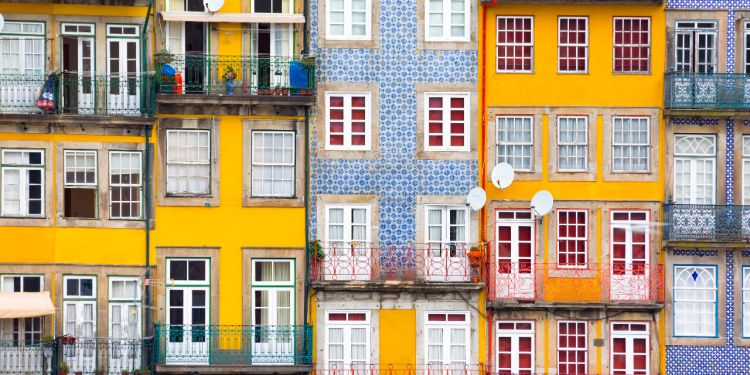
Most people visiting Porto for the first time spend most of their time exploring the downtown, and the same thing goes for expats looking for a home here. This means most of the remaining areas in the city are still quite under the radar. Fear not, since this article will clue you in. Take a special look at Baixa, Foz do Douro, Matosinhos, Vila Nova de Gaia and Boavista when looking for the perfect place for you to live.
Crime rate in Porto
Overall, Porto is a very safe city, something that extends to the entire country since Portugal has recently ranked 7th in the 2023 Global Peace Index. Funny enough, the downtown area, which is today considered prime real estate, was widely considered a no-go zone back in the 90s, as the city center was riddled with drug users, sex workers and petty crime. Nowadays, things have taken a complete turn, to the point locals actually want to live there but can no longer afford to do so!
Parking in Porto
Aside from a few notable exceptions, Porto's city center is mainly composed of narrow cobblestone streets and steep lanes, making it extremely difficult to find classical buildings that actually boast a parking space/garage. As a result, residents usually have to park on the street with a resident's permit. If you have a car and are visiting a central area where you're not a resident, then you need to get a ticket from the nearest pay and display machine. Porto's parking system is split across 4 different categories/zones, where you'll pay between 0.40€ and 1.20€/hour. In zones II and III, it's also possible to buy a daily ticket for 3.60€ and 2.40€, respectively.
City Center: Baixa do Porto
The Downtown District, or Baixa, is Porto's historical and spiritual core. What used to be a place filled with prostitutes, drug addicts and all sorts of criminals living door-to-door with humbler families is nowadays a thriving area where bohemian entertainment peeks at every corner. If you visited Porto, chances are you could have never guessed about its criminal past since it is now a colorful, bright and safe place to stroll around. This is the district where it all happens and your place of choice if you are looking for a busy, hectic and upbeat lifestyle. However, this is also an area where prices are skyrocketing as days go by, leading to a serious gentrification scenario, with most buildings currently being used for tourism rather than for accommodating local families.
Seaside districts: Foz do Douro and Matosinhos
Foz do Douro is a lovely seaside neighborhood and a rather exclusive area where the upper class enjoys high standards of living and commodities not everybody can afford – as such, housing is also quite pricey. A bit further west, the same goes for Matosinhos. Though not as expensive, this is still an area of the city (specifically Matosinhos-Sul) not everyone is able to afford. Still, if you're running on a North American or Western European wage, you probably won't find it that bad and will be able to enjoy the highest standard of living in Porto. The sea breeze will become part of your daily routine, and you will get the chance to jog through the promenade, walk your dogs, or simply admire the sea while enjoying some ice cream — some of the locals' favorite activities! Plus, Matosinhos is also served by the rather efficient local metro system, getting you into the downtown in around 30 minutes.
The other side of the river: Vila Nova de Gaia
As soon as you have crossed any of the six bridges over the Douro, you can positively say that you have set foot in the district of Vila Nova de Gaia — the land on the other side of the Douro. Though not at the same level as before (depending on the location), rent prices are lower in Vila Nova de Gaia when compared to the cost of living in most other city districts. As a result, and to this day, Vila Nova de Gaia stands as one of the country's finest examples of a dormitory town, with most people working in Porto and commuting back after work. Granted, VNG doesn't offer the same excitement when it comes to infrastructure, bars, restaurants, cafes, and things to do, but at least you'll get greater purchasing power.
The business district: Boavista
Located northwest of the downtown, Boavista is the city's unofficial business district, though there are plenty of residential blocks. The neighborhood is very well connected to the rest of the city and, much like Foz do Douro, is an area where upscale families used to buy and invest in property. Furthermore, the area is mostly known for one thing: being the starting point to the biggest avenue in Portugal!
Budget-friendlier: Rio Tinto, Valongo and Gondomar
Finally, it's worth pointing out that the lowest rent prices in Porto can be found in the suburbs. In places like Valongo, Gondomar or Rio Tinto, you can still find decent apartments for around 600€, though these are getting more and more difficult to find as time goes by. However, there's not much going on in these districts, and aside from certain areas of Gondomar, which are actually served by the metro, having to rely heavily on public transportation to get to the city center will quickly drain your energy.
We do our best to provide accurate and up to date information. However, if you have noticed any inaccuracies in this article, please let us know in the comments section below.












Comments